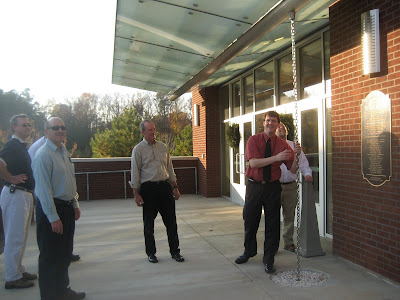
At midnight of June 6 (Beijing time), the lake water level rose to 740 m, the highest bottom elevation of the constructed drainage/sluice channel. The outflow was anticipated to start at that moment. However, a 0.4 m high dirt block was later constructed in the channel in order for soldiers to make the channel wider, deeper, and steeper (no specific channel dimensions were given). The soldiers were dispatched back to the dam to modify the channel in the afternoon of June 6.
At 7:08 a.m., June 7 (Beijing time), the "natural" outflow started. The reported flow rates were 2 cubic meters per second at 2:15 p.m. (with current velocity of 1.5 m/s) and 10 m3/s at 6:00 p.m. (at 741.02 m lake level). On June 8, the reported flow rates were 20 m3/s at noon (at 741.82 m) and 25 m3/s at 7:15 p.m. These inflow rates were much smaller than the reported rate of inflow to the lake, more than 100 m3/s.
The landslide dam was stable, but was not getting removed. The drainage channel was not scouring significantly and not getting much wider and deeper due to the relatively small outflow rate. The outflow rate is relatively small thus far since it would take some time to build up the lake water level/head above the channel bottom to push the water through. The slow water level rise is a result of the relatively small upstream inflow rate (due to the relatively small rainfall in the upstream watershed). The outflow rate was also reduced by partial blockage of the channel by debris floating down from the lake.
While clearing out or breaking down floating debris on the lake surface, we could simply wait for the lake water to rise several more meters so that all the inflow (more than 100 m3/s) would be pushed through the channel. We could also wait for the next rain storm that would lead to a higher outflow rate. The high outflow rate (more than 100 m3/s) would scour the existing channel deeper and wider and would eventually form a relatively stable channel through the landslide dam. If we are lucky enough, there might not be much of the landslide dam left afterward. This was exactly what Chinese engineers originally planned for, I assume.
However, understandably, Chinese leaders, engineers, and especially over 200,000 residents who have been relocated to the high ground since about ten days ago (plus other over one million residents on high alert for emergency evacuation) are running out of patience.
To increase the outflow rate, it was decided yesterday to dig another, deeper channel several meters away from the existing channel. These two channels are anticipated to merge together once the dirt barrier between the two channel is washed away during a high flow.
At the end of the second channel digging, the soil/debris pile at the inlet would have to be removed by a remotely-controlled explosion. Since the inlet bottom elevation would be below the lake water level at that time, once the inlet is blast open, water will gush out from the "quake lake", in addition to that being released out from the first channel.
My four concerns for digging the second channel, in comparison to waiting for a "natural" enlargement of the first channel:
1) Engineers and soldiers are working in a highly risky environment;
2) The explosion used to open the channel inlet, though of relatively small strength, might still trigger a catastrophic collapse of the landslide dam;
3) The sudden gush of water, immediately after the explosion, might create an impact or shear force too strong for the dam to stand, leading to a catastrophic collapse;
4) The wider channel (the existing plus the new) would lead to a lower lake level (a smaller head) in front of the channel and a smaller current velocity. The smaller current velocity may not be sufficiently large to continue scour the channel(s) and to eventually remove the dam.
My best wishes to the additional efforts to release water from the landslide dam at Tangjiashan, but maybe a better option is to leave where it is and let the first channel do the entire job, "naturally!"
Therefore, I would like to suggest a halt to construction of the second channel on the dam.
我建议停止开挖第二条导流渠。原因如下:
1。现有的导流渠正冲得越宽越深,泄流量正变得越来越大,也就是说,正在平稳走向全功能发挥作用。我估计再过一至两天,水位就会涨到一定高程(最多涨到 744 米),排水流量就可以达到每秒一百多立方米,泄水量就会大于进水量,湖水位就会开始降落而越来越底。 继续开挖第二条导流渠就没有必要了。
2。继续开挖第二条导流渠可能会带来溃坝的风险。进水口要炸开,爆炸本身有可能引起溃坝。炸开口后的突然大量来流也有可能引起坝趾过度冲刷而掏空,而溃坝。
3。两条渠道加起来可能会太宽,水头会太底,流速会太底,而无法达到既慢慢冲走堰塞体又不发生倾刻溃决的最理想目的。
4。工程师和战士们现在在堰塞体上操作有一定的生命危险。
Info source: Xinhuanet
 I knew it had been raining since yesterday, but was the bridge (that I normally drove across to work) closed?
I knew it had been raining since yesterday, but was the bridge (that I normally drove across to work) closed?











